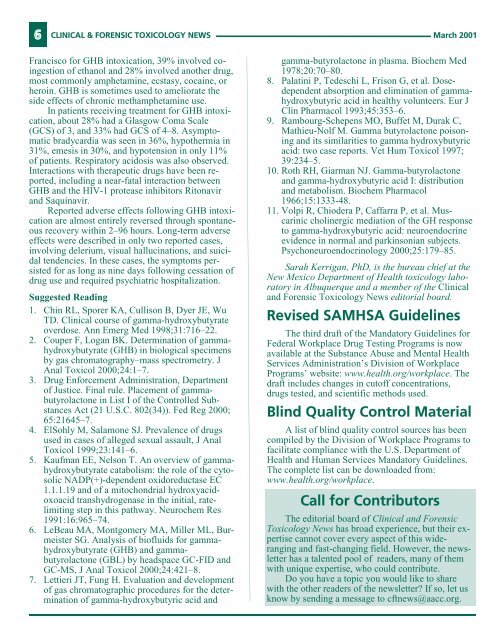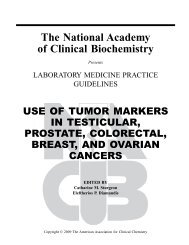CLINICAL & FORENSIC Toxicology News - American Association ...
CLINICAL & FORENSIC Toxicology News - American Association ...
CLINICAL & FORENSIC Toxicology News - American Association ...
Create successful ePaper yourself
Turn your PDF publications into a flip-book with our unique Google optimized e-Paper software.
<strong>CLINICAL</strong> & <strong>FORENSIC</strong> TOXICOLOGY NEWS March 2001<br />
Francisco for GHB intoxication, 39% involved coingestion<br />
of ethanol and 28% involved another drug,<br />
most commonly amphetamine, ecstasy, cocaine, or<br />
heroin. GHB is sometimes used to ameliorate the<br />
side effects of chronic methamphetamine use.<br />
In patients receiving treatment for GHB intoxication,<br />
about 28% had a Glasgow Coma Scale<br />
(GCS) of 3, and 33% had GCS of 4–8. Asymptomatic<br />
bradycardia was seen in 36%, hypothermia in<br />
31%, emesis in 30%, and hypotension in only 11%<br />
of patients. Respiratory acidosis was also observed.<br />
Interactions with therapeutic drugs have been reported,<br />
including a near-fatal interaction between<br />
GHB and the HIV-1 protease inhibitors Ritonavir<br />
and Saquinavir.<br />
Reported adverse effects following GHB intoxication<br />
are almost entirely reversed through spontaneous<br />
recovery within 2–96 hours. Long-term adverse<br />
effects were described in only two reported cases,<br />
involving delerium, visual hallucinations, and suicidal<br />
tendencies. In these cases, the symptoms persisted<br />
for as long as nine days following cessation of<br />
drug use and required psychiatric hospitalization.<br />
Suggested Reading<br />
1. Chin RL, Sporer KA, Cullison B, Dyer JE, Wu<br />
TD. Clinical course of gamma-hydroxybutyrate<br />
overdose. Ann Emerg Med 1998;31:716–22.<br />
2. Couper F, Logan BK. Determination of gammahydroxybutyrate<br />
(GHB) in biological specimens<br />
by gas chromatography–mass spectrometry. J<br />
Anal Toxicol 2000;24:1–7.<br />
3. Drug Enforcement Administration, Department<br />
of Justice. Final rule. Placement of gammabutyrolactone<br />
in List I of the Controlled Substances<br />
Act (21 U.S.C. 802(34)). Fed Reg 2000;<br />
65:21645–7.<br />
4. ElSohly M, Salamone SJ. Prevalence of drugs<br />
used in cases of alleged sexual assault, J Anal<br />
Toxicol 1999;23:141–6.<br />
5. Kaufman EE, Nelson T. An overview of gammahydroxybutyrate<br />
catabolism: the role of the cytosolic<br />
NADP(+)-dependent oxidoreductase EC<br />
1.1.1.19 and of a mitochondrial hydroxyacidoxoacid<br />
transhydrogenase in the initial, ratelimiting<br />
step in this pathway. Neurochem Res<br />
1991:16:965–74.<br />
6. LeBeau MA, Montgomery MA, Miller ML, Burmeister<br />
SG. Analysis of biofluids for gammahydroxybutyrate<br />
(GHB) and gammabutyrolactone<br />
(GBL) by headspace GC-FID and<br />
GC-MS, J Anal Toxicol 2000;24:421–8.<br />
7. Lettieri JT, Fung H. Evaluation and development<br />
of gas chromatographic procedures for the determination<br />
of gamma-hydroxybutyric acid and<br />
gamma-butyrolactone in plasma. Biochem Med<br />
1978;20:70–80.<br />
8. Palatini P, Tedeschi L, Frison G, et al. Dosedependent<br />
absorption and elimination of gammahydroxybutyric<br />
acid in healthy volunteers. Eur J<br />
Clin Pharmacol 1993;45:353–6.<br />
9. Rambourg-Schepens MO, Buffet M, Durak C,<br />
Mathieu-Nolf M. Gamma butyrolactone poisoning<br />
and its similarities to gamma hydroxybutyric<br />
acid: two case reports. Vet Hum Toxicol 1997;<br />
39:234–5.<br />
10. Roth RH, Giarman NJ. Gamma-butyrolactone<br />
and gamma-hydroxybutyric acid I: distribution<br />
and metabolism. Biochem Pharmacol<br />
1966;15:1333-48.<br />
11. Volpi R, Chiodera P, Caffarra P, et al. Muscarinic<br />
cholinergic mediation of the GH response<br />
to gamma-hydroxybutyric acid: neuroendocrine<br />
evidence in normal and parkinsonian subjects.<br />
Psychoneuroendocrinology 2000;25:179–85.<br />
Sarah Kerrigan, PhD, is the bureau chief at the<br />
New Mexico Department of Health toxicology laboratory<br />
in Albuquerque and a member of the Clinical<br />
and Forensic <strong>Toxicology</strong> <strong>News</strong> editorial board.<br />
Revised SAMHSA Guidelines<br />
The third draft of the Mandatory Guidelines for<br />
Federal Workplace Drug Testing Programs is now<br />
available at the Substance Abuse and Mental Health<br />
Services Administration’s Division of Workplace<br />
Programs’ website: www.health.org/workplace. The<br />
draft includes changes in cutoff concentrations,<br />
drugs tested, and scientific methods used.<br />
Blind Quality Control Material<br />
A list of blind quality control sources has been<br />
compiled by the Division of Workplace Programs to<br />
facilitate compliance with the U.S. Department of<br />
Health and Human Services Mandatory Guidelines.<br />
The complete list can be downloaded from:<br />
www.health.org/workplace.<br />
Call for Contributors<br />
The editorial board of Clinical and Forensic<br />
<strong>Toxicology</strong> <strong>News</strong> has broad experience, but their expertise<br />
cannot cover every aspect of this wideranging<br />
and fast-changing field. However, the newsletter<br />
has a talented pool of readers, many of them<br />
with unique expertise, who could contribute.<br />
Do you have a topic you would like to share<br />
with the other readers of the newsletter? If so, let us<br />
know by sending a message to cftnews@aacc.org.
















